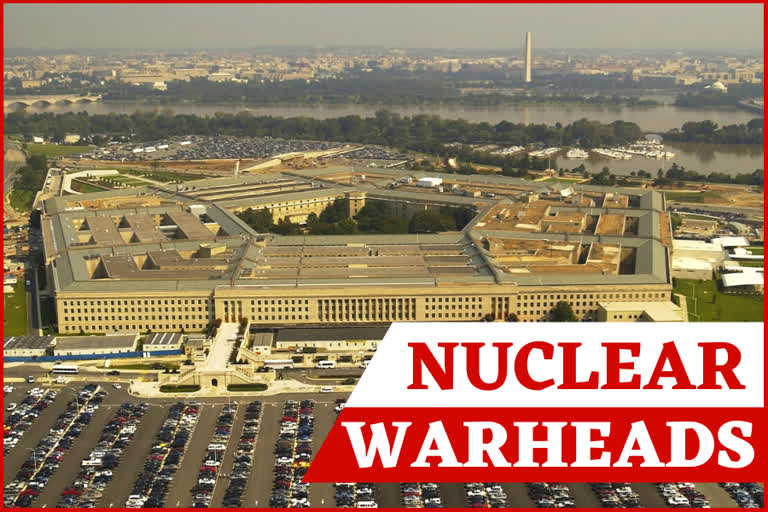Washington: China likely plans to double its stockpile of nuclear warheads in this decade, including those designed to be carried atop ballistic missiles that can reach the United States, the Pentagon said in a report released on Tuesday.
Even with such increases, China's nuclear force would be far smaller than that of the United States, which has an estimated 3,800 warheads inactive status and others in reserve. Unlike the US, China has no nuclear air force, but the report said that gap may be filled by developing a nuclear air-launched ballistic missile.
The Trump administration has been urging China to join the US and Russia in negotiating a three-way deal to limit strategic nuclear arms, but China has declined. Chinese Foreign Ministry officials have said China's arsenal is too small to be included in negotiated limits and that by pressing China to join in such talks the Trump administration has created a pretext for walking away from the existing US-Russia arms treaty known as New START. That deal is due to expire in February but could be renewed for up to five years if Moscow and Washington agree.
Read | Trump visits Kenosha, calls violence 'domestic terrorism'
In its annual “China Military Power” report to Congress, the Pentagon said the modernization and expansion of China's nuclear forces are part of a broader effort by Beijing to develop a more assertive position on the world stage and to match or surpass America by 2049 as the dominant power in the Asia-Pacific region.
“China's nuclear forces will significantly evolve over the next decade as it modernizes, diversifies, and increases the number of its land-, sea-, and air-based nuclear delivery platforms,” the report said. “Over the next decade, China's nuclear warhead stockpile — currently estimated to be in the low 200s — is projected to at least double in size as China expands and modernizes its nuclear forces.”
Read | India, China should take concrete measures to safeguard peace at LAC: Beijing
Within that force, the number of nuclear warheads on land-based intercontinental ballistic missiles capable of threatening the United States — currently about 100, according to the report — is expected to grow to roughly 200 in the next five years, it said.
Hans Kristensen, a nuclear weapons expert at the Federation of American Scientists and a specialist in China's force, said the “low 200s” Pentagon estimate is slightly lower than his estimate of about 300.
The low number of course somewhat weakens the Trump administration's warnings about Chinese capabilities and its concerns that Beijing may be aiming to achieve nuclear parity with the United States, he said.
Tuesday’s report to Congress is not the first time the Pentagon has predicted a doubling of China's nuclear stockpile. In a speech at the Hudson Institute in May 2019, the then-director of the Defense Intelligence Agency, Lt. Gen. Robert Ashley, said, “Over the next decade, China will likely at least double the size of its nuclear stockpile in the course of implementing the most rapid expansion and diversification of its nuclear arsenal in China’s history.” Ashley said China's stockpile was in the “low couple hundred.”
Those predictions fit neatly with arguments the Trump administration makes to justify spending hundreds of billions of dollars to modernize the US nuclear arsenal.
Defence Secretary Mark Esper himself made this connection three days before the Pentagon's China report was released.
“As Communist China moves to at least double the size of its nuclear stockpile, modernizing our nuclear force and maintaining readiness is essential to a free and open Indo-Pacific,” he wrote on Twitter.
The Trump administration is pursuing a plan, begun during the Obama administration, to replace all major elements of the nuclear force — submarines, long-range bombers, and land-based missiles — over the next 30 years at a cost projected to top $1 trillion, including the expected cost of sustaining and operating the force and of updating warheads as well as command and control systems. It's unclear whether the full plan would be pursued in the event Democrat Joe Biden wins in November.
Chad Sbragia, the deputy secretary of defence for China policy, said in an interview Monday with a small group of reporters that China's nuclear expansion plan may foreshadow even more ambitious plans.
“An ability to double the stockpile not only demonstrates a move away from their historical minimum deterrence posture but places them in a position where they can readily grow their force beyond this number,” Sbragia said.
The Pentagon report also raised the possibility that China may adopt a higher level of nuclear combat readiness. Currently, it keeps its nuclear warheads stored separately from its missiles and launchers and thus would need the warning to get them ready for war.
The report said unspecified evidence emerged in 2019 indicating that China wants to keep at least a portion of its force on a higher state of alert known as launch on warning, meaning for example that its silo-based ICBMs would be armed in peacetime and ready for launch on short notice, which is the way the US ICBM force operates.
(AP)



